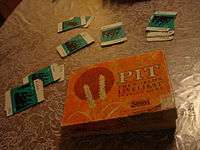Pit (game)
Pit is a fast-paced card game for three to eight players, designed to simulate open outcry bidding for commodities. The game was developed for Parker Brothers and first sold in 1904. It is currently being produced by Winning Moves. This popular version of the game was developed by Edgar Cayce,[1] who would also become famous for his alleged psychic talents.[2]
 The box and cards for Pit | |
| Publisher(s) | Winning Moves |
|---|---|
| Years active | 1904–present |
| Genre(s) | Trading card game |
| Players | 3 to 8 players |
| Setup time | 1 to 2 minutes |
| Playing time | 1 to 10 minutes per round, any number of rounds |
| Random chance | Dealing cards, blind trades |
| Skill(s) required | Hand management, Deal making |
The inspirations were the Chicago Board of Trade (known as 'The Pit') and the US Corn Exchange and it was likely based on the very successful game Gavitt's Stock Exchange, invented in 1903 by Harry E. Gavitt of Topeka, Kansas (and reprinted in 2004 in an authentic "heirloom" edition by Out of the Box Publishing). Versions of the game have been marketed under the names Billionaire, Business, Cambio, Deluxe Pit, Quick 7, and Zaster.[2]
Contents
Some decks consist of 74 cards with nine cards each of eight different commodities. The specific commodities have varied over the various editions of the game, but those used in most modern editions are Barley, Corn, Coffee, Oranges, Oats, Soybeans, Sugar and Wheat. The classic version has seven commodities: flax, hay, oats, rye, corn, barley, and wheat. Two special cards are also included, the Bull and the Bear; use of these cards is optional.
Versions of the game starting in the 1970s contained a bell used to start trading. The first player to hold all nine cards of a commodity would ring the bell.[2]
Play
The number of commodities included in each round is equal to the number of players. Each player is dealt nine cards; two players get ten if the Bull and Bear are included.
Pit has no turns, and everyone plays at once. Players trade commodities among one another by each blindly exchanging one to four cards of the same type. The trading process involves calling out the number of cards one wishes to trade until another player holds out an equal number of cards. The two parties then exchange the cards face down.
When a player has nine cards of the same commodity, they will call out "Corner on..." the commodity they have obtained, ending the round. (In deluxe editions of the game, a bell is rung instead.) That player then earns points equal to the number value of the commodity they "went out" with.
The Bull and the Bear
The Bull card is considered wild and can be used to complete any set. If a player wins a round while holding all nine cards of one commodity as well as the Bull, they earn double the score for that round. A player cannot win while holding the Bear. At the end of each round, the player holding the Bear and any losing player holding the Bull each forfeit 20 points.
The game ends when either a set number of rounds have been played, or when a player reaches a certain agreed-upon point total.
Phrases often used during play
- Chasing the bear: When one attempts to follow the progress of the bear after trading it away by watching the following trades.
- Corner on the cob: Cornering the market on corn.
- Going for a hay ride: When one attempts to pick up all of a commodity that one has little of, because one has traded enough of it back and forth that one has an idea where it is all located.
- Slip them the bear: When one trades away the bear, usually just before the game ends.
- The granary: A player's hand.
- Getting flaxed: Inadvertently acquiring an abundance of flax, the commodity with the lowest value.
- Flaxing out: Cornering the market on flax.
- Bear trap: Receipt of the Bear just preceding the ring of the bell to signify the game's end; doubly nasty if receipt of the Bear was part of the final trade that facilitated the winning hand.
Variations
The original edition contained only seven commodities.
| Commodity | Value |
|---|---|
| Wheat | 100 |
| Barley | 85 |
| Corn | 75 |
| Rye | 70 |
| Oats | 60 |
| Hay | 50 |
| Flax | 40 |
Newer versions include seven or eight commodities, replacing Flax, Hay and Rye with Oranges, Coffee, Sugar and Soybeans.
| Commodity | Value |
|---|---|
| Wheat | 100 |
| Barley | 85 |
| Coffee | 80 |
| Corn | 75 |
| Sugar | 65 |
| Oats | 60 |
| Soybeans | 55 |
| Oranges | 50 |
The 100th anniversary edition released in 2004 included a reproduction of the original edition as well as a brand new edition that featured 8 "modernized" commodities.
| Commodity | Value |
|---|---|
| Cocoa | 100 |
| Platinum | 85 |
| Gold | 80 |
| Cattle | 75 |
| Oil | 65 |
| Rice | 60 |
| Silver | 55 |
| Gas | 50 |
References
- Bro, Harmon (1997). A Seer out of Season. New York: St. Martin's. p. 305. ISBN 0-312-95988-5. citing article "The Pit: Copies of Game Invented by Bowling Green Man Received Here". Bowling Green Times Journal. 1904.
- History of Pit at boardgamegeek.com. Accessed August 2007
